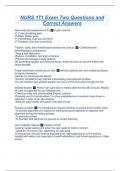NURS 171 Exam Two Questions and
Correct Answers
Neurovascular assessment 5 Ps ✅-P:pain (Ouch!)
-P: Pulse (throbbing pain)
-P:Pallor (White, pale)
-P: Paresthesia (Can you feel this?)
-P: Paralysis (Can you move this?)
Traction, casts, and immobilization devices are used to: ✅-Correct/improve
deformities/joint contractures
-Treat a joint dislocation
-Reduce, immobilize, and align a fracture
-Prevent and manage muscle spasms
-By controlling spasms and fractured bones, these devices can prevent further soft
tissue damage
Proper and timely monitoring are vital: ✅-Monitor patients skin and underlying tissues
for signs of pressure
-Monitor for neurovascular deficits
-Sensory complaints may indicate a developing neurovascular problem
-Pin site infection with skeletal traction can occur at the entry point through the skin
Skeletal traction ✅-Perform pin care daily or weekly after the first 48-72 hours. Weekly
pin care is supported for non-infected pins
-Clean pus sites with chlorhexidine 2mg/mL solution
-Dressing use 5% chlorhexidine/ 1% silver sulphadiazine or xeroform have shown a
reduction in rates of pin site infection
-Wrap pin sites loosely with gauze until sites are dry
Purpose of casts: ✅-To immobilize an injured extremity to protect it from further injury
-To provide alignment of a fracture by holding the bone fragments in reduction and
alignment during the healing process
-To promote comfort
-To maintain limb alignment to prevent or correct deformity
Cast materials: Natural ✅-Plaster or Paris
-Used for serial casting and when the cast needs to mold or conform
-Takes 24-72 hours to dry, depending on cast sizes
-During drying, the cast must be exposed to air, well supported on a firm surface,
handled with palms (not fingertips) to avoid indentations, and turned regularly so it dries
evenly.
,Cast materials: Synthetic ✅-Preferred material
-Sets quickly (about 15 minutes)
-Can withstand pressure or weight bearing after 20 minutes
Unexpected cast outcomes ✅-Patient experiences impaired physical mobility related to
the cast
-Patient reports increased severity in pain after application of the cast
-Patient develops compartment syndrome with severe pain unrelieved by analgesic;
change in neurovascular status
-Patient/ family caregiver could not provide an explanation of how to care for cast after
application/removal
Skin Traction: ✅Skin traction us the application of pulling force directly to the skin and
soft tissue that indirectly pulls on the skeletal system
Functions of skin traction: ✅-Immobilizes a fracture and relieves muscle spasms and
pain through the use of continuous traction
-Usually provides temporary immobilization until the fracture can be repaired surgically
by open reduction and internal fixation or skeletal traction
-Maintains alignment and reduces contractures and dislocations
Types of skin traction: ✅Bucks, Dunlops, Russells, Cervical
Skin breakdown and skin traction ✅-The more weight applied to the traction, the
greater the risk of skin breakdown
-Contraindications to skin traction includes pressure ulcers, dermatitis, burns, and
abrasions
-Older patients with tissue perfusion problems are at increased risk of skin breakdown
-When caring for patients in skin traction, initially and regularly monitor patient for
correct maintenance of the traction device and proper musculoskeletal alignment
Traction assessment: ✅-Maintenance the established line of pull
-Maintenance traction equipment/ordered weight
-Maintain counteraction
-Maintain continuous traction unless ordered otherwise
-Maintain correct body alignment
-Prevent friction to the skin
-Pain scale of 0-10
-Neurovascular status
Planning/expected outcomes
Delegation and collaboration ✅-Neurovascular assessment of the patients condition
cannot be delegated. The skill of assisting with application of skin traction can be
delegated to nursing assistant who have had specific training
, -The nurse instructs the NA to: inform the nurse is patient demonstrates any change in
skin condition or complains of discomfort
Skeletal traction immobilizes: ✅-Fractures of the cervical spine
-Fractures of the femur below the trochanter
-Some fractures of the bones of the arm or ankle
Skeletal traction: ✅-It immobilizes the femoral head when there is an acetabular
fracture
-Skeletal traction is being used less frequently because of newer surgical repair
procedures
-Skeletal traction involves piercing the skin at the site where the pin enters and exits
-Because skeletal traction involves placement of a pin, meticulous pin-site care reduces
the risk of pin-traction infections
-Prolonged immobilization influences nursing care, which focuses on supporting ADLs,
maintaining and preventing fat embolism and complications of immobility (skin
breakdown, pulmonary emboli)
External Fixation devices: ✅External fixation devices promote early ambulation and
use of other joints while maintaining immobilizations of affected bones
Care of pt with an immobilization devices ✅-The abduction splint or pillow, used after
hip replacement surgery, maintains the patient's legs in an abducted position
-Braces, made of sturdy materials such as leather, metal, and molded plastic, support
weakened structures during weight bearing
Types of braces: ✅chest, abdominal, lumbar, short leg, long leg
Pressure ulcers: ✅-Pressure ulcers are localized areas of tissue destruction caused by
the compression of soft tissues over a bony prominence and an external surface for a
prolonged period of time.
-Pressure ulcers can occur when patients are sitting and when an external source such
as a cast edge applies unrelieved pressure to skin.
Anterior pressure points: ✅Chin, iliac crest, trochanter, knee, pretibial crest
Posterior pressure points: ✅Occipital, scapula, elbow, spinous process, lacrum,
ischium, malleolus, heel
Common sites for pressure ulcers: ✅Sacrum, heels, elbows, lateral malleoli,
trochanter, ischial tuberosity
3 External factors: ✅Shear, friction, moisture make the tissues less tolerant to
pressure




